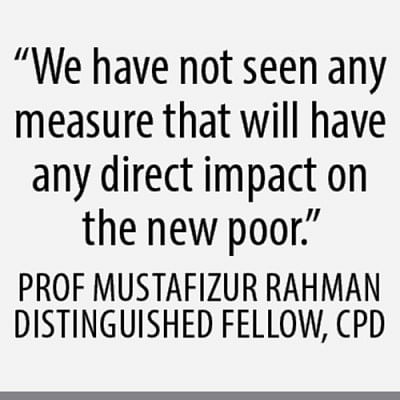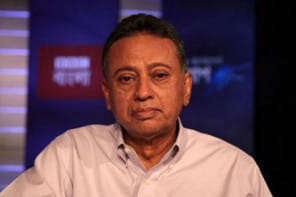A budget that forgot new poor exists


Expectations were high that the proposed budget for fiscal 2021-22 would address the hardships of the sizeable population of new poor created by the pandemic.
But it failed on that count, said the Centre for Policy Dialogue yesterday.
"We have not seen any measure that will have any direct impact on the new poor," said Mustafizur Rahman, a distinguished fellow of the CPD, at a media briefing to disclose the think-tank's analysis of the Tk 603,680 crore budget announced by Finance Minister AHM Mustafa Kamal on Thursday.
About 20.5 percent of the population was already living in poverty and the pandemic added another 1.60 crore to the group, according to an estimate of the CPD in April.
In the same month, another survey by the Power and Participation Research Centre and the Brac Institute of Governance and Development showed that the ongoing economic shock pushed 2.45 crore people into poverty even before the second wave of the pandemic hit.
The World Bank also said Bangladesh's poverty rate jumped to 30 percent due to the pandemic.
The Bangladesh Bureau of Statistics does not have the latest data on poverty; its most recent one dates back to 2019, when the poverty rate was estimated to be 20.5 percent.
"We have discussed a lot about the new poor and marginalised poor due to Covid-19 but their issues were not addressed in the budget," Rahman said at the briefing held at the capital's Lakeshore Hotel.
The government has allocated Tk 107,610 crore for social protection schemes for the upcoming fiscal year, which is up 12 percent but lower than the average 17 percent growth of allocation between fiscals 2009-10 and 2021-22.
Of the amount, the government has set aside Tk 26,690 crore -- one-fourth of the sum -- to provide pension to retired government employees. This is an increase of 16 percent from fiscal 2020-21, and higher than the rise in allocation for social safety net schemes.
Besides, the allocation has been cut for programmes protecting livelihoods such as the Work for Money and the Skills and Employment Programme in the incoming fiscal year, according to the CPD.
The allocation has also been cut for several programmes that address the needs of the marginalised, vulnerable and left-behind communities.
This means the new poor will be largely deprived of getting benefits from the programmes.
"The philosophy of the budget is to reduce the inequality of income, consumption and wealth between the poor and the rich. But measures for bringing down inequality is not visible. The government should have widened the allocation for social safety net programmes," Rahman said.
The government should have increased the amount of allocation in public spending and investment for creating more employment amid the pandemic, the CPD said.
For instance, the proposed budget for fiscal 2021-22 is 17.5 per cent of the total GDP.
In India, the ratio of public expenditure to the GDP is 26 percent. It is 30 percent in both Nepal and Bhutan and 28 percent in Vietnam.
But, the actual implementation rate, the ratio of public expenditure to the GDP, in Bangladesh usually decreases to 16 percent, whereas the average ratio in the South Asian nations is 25 percent of the GDP, he said.
The budget document does not have much to offer in terms of concrete measures and innovative policies to combat the Covid-induced challenges, the CPD said.
The tax exemption, value-added tax and duty benefits proposed in the budget are expected to stimulate private investment, create jobs and indirectly benefit the economy, Rahman said.
"But private investment cannot be stimulated through tax benefits only. It also depends on the ease of doing business and competition in the market. So, the tax benefit can be termed as a necessary condition not sufficient," he added.
Khondaker Golam Moazzem, research director of the CPD, went on to call for a second stimulus package for the cottage, micro, small and medium enterprises (CMSMEs) as only reducing tax is not enough to resolve the existing problems of those businesses.
The government should allocate an additional fund of Tk 30,000 crore for the CMSMEs to take the total allocation to Tk 50,000 crore for revival of the affected CMSME units, which will help generate employment.
The higher allocation for mega projects in the incoming year was unnecessary in the face of rising poverty, he said.
For instance, the highest allocation was given to the Rooppur nuclear power plant, raising a question to this end, he said.
"The country does not require additional electricity due to the surplus production at this moment. But the situation is quite different for commoners. In the absence of help from the government, they cannot live their lives smoothly."

For instance, the people of Koyra have been struggling to build an embankment to save themselves from tidal surges, Moazzem added.
Given the magnitude of negative impact on various sectors due to Covid-19, the CPD had emphasised the need for a medium-term strategy for economic recovery.
"The budget for fiscal 2021-22 has no indication of this," said Fahmida Khatun, executive director of the CPD.
In his budget speech in the parliament, Kamal mentioned that health, agriculture and employment generation have been given priority while allocating resources for the annual development programme.
However, actual allocation does not reflect this as these promises have not been supported by adequate resources, the CPD said.
"This puts under risk the fulfilment of the promise made in the 50th budget to move towards a resilient future by giving priority to lives and livelihoods," Khatun said.
There was no specific mention of an allocation for purchasing vaccines, which is highly important for the nation to get out of the pandemic woes, said Towfiqul Islam Khan, senior research fellow of the CPD.
The government had kept aside Tk 32,731 crore for the health sector in the upcoming fiscal year, which is an increase of 12 percent year-on-year.
The allocation for the health sector as a share of GDP stands at 0.95 per cent, which has almost remained the same as this fiscal year's. The ratio is 0.83 percent in fiscal 2020-21.
"Surprisingly, even the pandemic was not reason enough for the government to prioritise the healthcare sector," Fahmida Khatun said while presenting the keynote paper at the event.
The education sector had been hit hard by the pandemic since March last year when the coronavirus began putting down its roots in Bangladesh.
The government has kept aside Tk 71,953 crore for the proposed budget, an increase of 8.68 per cent year-on-year.
The share of the education budget as a percentage of GDP decreased to 2.08 percent from 2.14 percent this fiscal year, she said.
The government should have increased the allocation to a large extent such that educational institutions can carry out classes through the online platform, Khatun added.

 For all latest news, follow The Daily Star's Google News channel.
For all latest news, follow The Daily Star's Google News channel. 



Comments